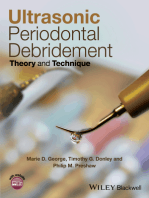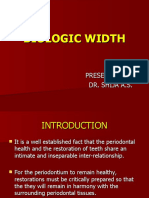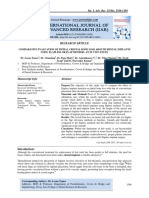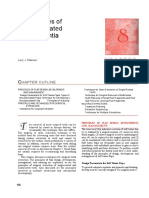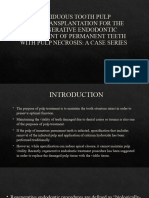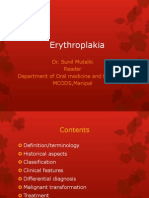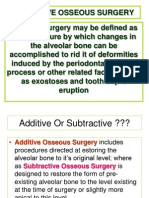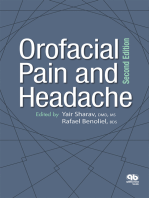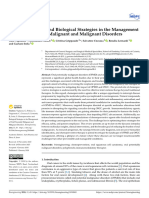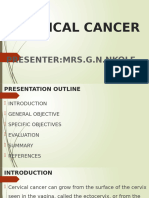Oral Premalignant Lesions
Oral Premalignant Lesions
Copyright:
Available Formats
Oral Premalignant Lesions
Oral Premalignant Lesions
Original Description:
Copyright
Available Formats
Share this document
Did you find this document useful?
Is this content inappropriate?
Copyright:
Available Formats
Oral Premalignant Lesions
Oral Premalignant Lesions
Copyright:
Available Formats
Volume 8, Issue 1, January – 2023 International Journal of Innovative Science and Research Technology
ISSN No:-2456-2165
Oral Premalignant Lesions
Dr. Indushree D
Abstract:- This paper provides an general overview of Dyskeratosis congenita
oral premalignant lesions and conditions , reasons and Lupus erythematosus
causes behind this premalignant lesions and conditions
and how to identify these conditions and differentiate
them from other non cancerous lesions and this paper
also provides information on early signs and Symptoms
along with signs and symptoms during the later stages
and complications associated and also provides
information on etiopathogenesis and as of how to
diagnose these lesions clinically and by different
laboratory tests and also gives an overview on
management a of these lesions.
I. INTRODUCTION
Precancerous lesion, It is an applied state of tissue
often, but not always has a high potential to undergo
malignant transformation. Some benign lesions or
conditions for varying length of time, also generally precede
oral cancer. Interestingly, these lesions or conditions share Fig 1 Showing Histological Chances In Different Grades Of
same etiological factors with oral cancer, particularly the use Cancer
of tobacco and exhibit same habit and relationship .Many of
them show high potential to become cancer and are, II. PRECANCEROUS LESIONS
therefore, termed as precancerous lesion.
Stages of Precancerous Lesions
It is especially important to remember that a
premalignancy is not guaranteed to eventually transform
into cancer ,as is often but erroneously believed. Individual
with oral precancer has 69 times greater risk of developing
oral cancer as compared to tobacco users who do not have
precancer.
Definition
Precancerous lesion: It is defined as a morphologically
altered tissue in which cancer is more likely to occur,
than its apparently normal counterparts.
Precancerous condition: It is defined as a generalized
state or condition associated with significantly increased
risk for cancer development.
Some of oral precancerous lesions are:
Leukoplakia
Erythroplakia
Mucosal changes associated with smoking habits
Carcinoma in situ
Bowen disease
Actinic keratosis, cheilitis and elastosis.
Some of precancerous conditions are :
Oral submucous fibrosis
Syphilis
Sideropenic dysplasia
Oral lichen planus Fig 2 Showing Types And Aetiology Of Oral Cancer.
IJISRT23JAN750 www.ijisrt.com 1206
Volume 8, Issue 1, January – 2023 International Journal of Innovative Science and Research Technology
ISSN No:-2456-2165
III. LEUKOPLAKIA
Definition
It is defined as any white patch on mucosa, which
cannot be rubbed or scraped off and which cannot be
attributed to any other diagnosable disease.
Who Definition
It is a whitish patch or plaque that cannot be
characterized, clinically or pathologically, as any other
disease and which is not associated with any other physical
or chemical causative agent except use of tobacco.
The term Leukoplakia originates from two greek words
leuko means white and plakia means a patch and the white
colour of mucosa results from the thickened surface of the
keratin layer.
Fig 4 Showing Non Homogeneous Leukoplakia
Erythroleukoplakia- leukoplakiai is present in
Association with Erythroplakia.
According to etiology
Tobacco induced
Non tobacco induced
Fig 3 showing Leukoplakia of palate. According to High risk of future development of oral
cancer
Clinical Aspects ● High Risk Sites
Floor of mouth
Pre leukoplakia is defined as a low-grade or very mild Lateral or ventral surface of tongue
reaction of oral mucosa, appearing as a grey or greyish Soft Palace
white ,but never completely white area with slightly lobular
pattern and with indistinct borders blending into adjacent ● Low Risk Site
normal mucosa (Pindborg, et al,1968) Classification Dorsum of tongue.
Hard palate
According to clinical description:
Homogenous ● Intermediate Group
Flat : It has a smooth surface. All other sites or oral mucosa.
Corrugated: like a beach at ebbing tide. According to Histology
Pumice like :with pattern of fine fines Dysplastic
Wrinkled: like dry, craked mud surface. Non dysplastic
Non Homogenous According to extent
Nodular or speckled,- characterized by white specks or
nodules on erythematous base . Localised
Verrucous-slow growing papillary proliferations above Diffused
the mucosal surface that may be heavily keratinized.
Extensive lesions of this type is known as oral florid Etiopathogenesis
papillomatosis. Local Factors Local Factors Include
Ulcerated- lesions exhibit red area at the Periphery of Tobacco
which white patches are present. Alcohol
Sanguinaria
IJISRT23JAN750 www.ijisrt.com 1207
Volume 8, Issue 1, January – 2023 International Journal of Innovative Science and Research Technology
ISSN No:-2456-2165
Chronic irritation
Candidiasis
Electromagnetic reaction or galvanism
Regional Systemic Factors
Syphilis
Vitamin deficiency
Nutritional deficiency
Xerostomia
Hormones
Drugs
Virus
Idiopathic
Fig 6 Showing Pathogenesis Of Candida Leukoplakia.
Sharp Staging
Stage 1 -Earliest lesion non palpable faintly translucent
white discoloration.
Stage 2- Localized or diffuse slightly elevated plaque of
irregular outline.
It is opaque white and me have fine granular texture.
Fig 5 Chart Showing Etiology Of Leukoplakia.
Stage 3-Thickened white lesion showing induration and
feasuring.
Clinical Features
Sex and age distribution- It occurs more commonly in Diagnosis
older age group I e 35 to 45 years and above males are
Clinical Diagnosis
more frequently affected than female, due to direct
Clinically any white patch with a history of tobacco
consequence of tobacco habit.
chewing which cannot be rubbed of is a Diagnostic indicator
Common site- It can occur anywhere on the oral mucosa, for leukoplakia.
buccal mucosa and comissure are more commonly
involved, lip lessons are more common in male and
Laboratory Diagnosis
tongue lesions are more common in females.
In biopsy hyperorthokeratosis of epithelium, epithelial
Extent -The extent of involvement may vary from small dysplasia, liquefaction degeneration, Basal cell hyperplasia
well localized irregular patches to diffuse lesions can be seen ,scanning electron microscopy will show
involving a considerable portion of oral mucosa, epithelial dysplastic changes.
multiple areas of involvement are not uncommon.
Colour- Lesson maybe white or a yellowish white but
with heavy use of tobacco it may assume brownish
colour.
Symptoms -Some patients may report a feeling of
increase thickness of mucosa, those with ulcerated and
nodular type may complain of burning sensation,
enlarged cervical lymph nodes maybe single occurrence
of metastasis.
IJISRT23JAN750 www.ijisrt.com 1208
Volume 8, Issue 1, January – 2023 International Journal of Innovative Science and Research Technology
ISSN No:-2456-2165
IV. GUIDELINE FOR MANAGEMENT OF
LEUKOPLAKIA
Fig 7 Chart Staging of Leukoplakia.
Malignant Potential
It is higher in women i e 6% than men i e 3.9% due to
involvement of endogenous factors.
Differential Diagnosis
Lichen planus
Chemical burn
White sponge nevus
Discoid lupus erythematosus
Psoriasis
Leukoedema
Hairy leukoplakia
Cheek biting lesion
Electro Galvanic white lesion.
Management
Elimination of Etiological Factors
Prohibition of smoking
Removal of chronic irritant
Elimination of other etiological factors
Conservative Treatment
Vitamin therapy
Vitamin A + vitamin E
13 cis retinoic acid Fig 8 Showing Management of Leukoplakia.
Antioxidant therapy
Vitamin A palmitate
Nystatin therapy
Vitamin B complex
Antibiotic preparation
Estrogen
IJISRT23JAN750 www.ijisrt.com 1209
Volume 8, Issue 1, January – 2023 International Journal of Innovative Science and Research Technology
ISSN No:-2456-2165
Erythroplakia Extent- unlike leukoplakia and erythroplakia is seldom
It is also called as erythroplasia of Queyrat, multiple and seldom covers extensive areas of mouth
erythroplasia is a persistent velvety red patch. Reddish ,also unlike leukoplakia, erythroplakia seldom expand
colour results from absence of surface keratin layer and due laterally after initial diagnosis ,because most lesions are
to presence of connective tissue papillae containing enlarged completely removed or destroyed immediately after
capillaries projected close to the surface. formal diagnosis .
Definition
It is applied to any area of red and velvet textured
mucosa that cannot be identified on the basis of clinical and
histopathological examination as being caused by
inflammation or any other disease process.
A chronic red mucosal macule which cannot be given
any other specific Diagnostic name and cannot be attributed
to traumatic, vascular or inflammatory causes
Fig 10 Showing Erythroplakia.
Diagnosis
Clinical Diagnosis
Red well demarcated patch with no sign of infection and
inflammation give rise to diagnosis of erythroplakia.
Toluidine blue test -Differentiation of erythroplakia with
malignant changes and early squamous cell carcinoma,
Fig 9 Showing Erythroplakia. from benign inflammatory lesions of oral mucosa is
enhanced by use of 1% toluidine blue test. Laboratory
Classification Diagnosis.
Homogeneous Biopsy exhibits epithelial changes ranging from mild
These commonly occur on buccal mucosa with a well dysplasia to carcinoma In Situ and even invasive
demarcated margin. carcinoma.
Erythroleukoplakia Differential Diagnosis
Erythroplakia interspersed with leukoplakia. Candidiasis
Granular or speckled these are elevated lesions. Denture stock
Tuberculosis
Etiology Histoplasmosis
Idiopathic Area of mechanical irritation
Alcohol and smoking Macular haemangioma
Candida infection. Telangiectasia
Traumatic lesion
Clinical Features
Age and sex- Male prediliction is seen and most Management
common in 6th and 7th decades of life. Removal of suspected irritate
Site- Occurs on all mucosal surface of head and neck Incisional Biopsy
area, half of all cases however are found on the Surgical stripping
vermillion or intra oral surfaces, with the rest being Destructive techniques such as laser electro
eventually divided between larynx and pharynx. coagulation, cryotherapy have also proven to be
Symptoms -As name obviously implies is asymptomatic effective.
Clinical follow up
IJISRT23JAN750 www.ijisrt.com 1210
Volume 8, Issue 1, January – 2023 International Journal of Innovative Science and Research Technology
ISSN No:-2456-2165
V. CARCINOMA IN SITU
Also called intra epithelial carcinoma .Severe
dysplastic changes in a white lesion indicate considerable
risk of development of Cancer. The most severe grade of
dysplasia merges with the condition known as carcinoma
Insitu. It is more common on skin but can also occur on
mucous brane.
Fig 12 Histological Image Showing Carcinoma Insitu.
Management
● Surgical removal: Lesions may be surgically excised,
cauterized and even exposed to solid carbon dioxide.
VI. PREMALIGNANT CONDITION LICHEN
PLANUS
The term lichen planus is derived since the lesion looks
like lichen on rocks and planus stands for flat, various
mucosal surfaces may be involved either independently or
concurrently with cutaneous involvement or serially.
Fig 11 Showing Histological Chances In Carcinoma Insitu
And Cancer. Definition
Lichen planus is a common inflammatory disease of
Clinical Features skin presenting with characteristic violaceous, polygonal,
Age and sex -Male predilection ia seen and occurs more pruritic papules. The disease may also affect the mucosa,
commonly in elderly person. hair and nails.
Site- Common site are floor of mouth, tongue and lips.
Appearance- Appearance of lesion maybe like It is a relatively common dermatological disorder
leukoplakia and erythroplakia. occurring on skin and oral mucous membrane refers to the
Lace -like pattern produced by symbiotic algae and fungal
Diagnosis colonies on the surface of rocks in nature. Prevalence of
Clinical diagnosis clinically cannot be differentiated lichen planus in general population is about 0.9% to 1.2%
and prevalence of oral lichen is reported in between 0.1%
from leukoplakia.
and 2.2%
Laboratory diagnosis
In biopsy keratin may or may not be present on the
surface of lesion but if present if more apt to be parakeratin
rather than Orthokeratin, loss of orientation of cell and loss
of polarity .Sharp line of division between normal and
altered epithelium extending from surface down to
connective tissue rather than blending of epithelium and
increase in nuclear cytoplasmic ratio nuclear
hyperchromatism are sometimes seen.
IJISRT23JAN750 www.ijisrt.com 1211
Volume 8, Issue 1, January – 2023 International Journal of Innovative Science and Research Technology
ISSN No:-2456-2165
Types
Reticular
Papular
Atrophic
Classical
Plaque
Erythematous
Ulcerative
Hypertrophic
Erosive
bullous
Hypertrophied
Annular
Actinic
follicular
linear
Fig 13 Showing Lichen Planus Of Lip.
Etiology
Cell mediated immune response
Auto immunity
Immune deficiency
Genetic factors
Infection
Psychogenic factor
Habit.
Fig 15 Showing Lichen Planus Involving Skin.
Clinical Features
Age and sex- It occurs in adulthood with age range for
males is 35 to 44 years and females is 45 to 54 years, it
has more female prediction
Oral and other mucous membrane symptoms -chief
complaint is usually of intense pruritus, itching
associated with lichen planus usually provokes rubbing
of lesion, rather than scratching.
Signs- Lesions have characteristic violet hue. They are
flat topped Shiny polygonal papules and plaques.
Fig 14 Showing Etiology And Management Of Lichen
Planus.
IJISRT23JAN750 www.ijisrt.com 1212
Volume 8, Issue 1, January – 2023 International Journal of Innovative Science and Research Technology
ISSN No:-2456-2165
Laboratory Diagnosis
There is hyper orthokeratosis, hyperparakeratosis,
acanthosis with intercellular oedema of spinous cells.
Biopsy also shows civatte bodies in spinous and basal cell
layers and lamina propria saw tooth appearance of rete pegs
is seen.
Immuno fluorescent study- Positive IgA and IgM and
IgG Antisera.
Differential Diagnosis
leukoplakia
candidiasis
Pemphigus
Lupus Erythematosus
Drug induced lesions
Ectopic Geographic tongue
Cheek biting
Lichenoid drug reaction
Management
Removal of a cause
Steroids
Steroid spray
Fig 16 Showing Lichen Planus of Buccal Mucosa. Steroid coating in soft custom tray
Topical delivery regimen
VII. ORAL LICHEN PLANUS Topical application of fluocinolone acetonide
Site- Common sites are buccal mucosa (84% )and to combination of prednisolone and levamisole
lesser extent tongue, lips, gingiva, floor of mouth and Topical application of antifungal agent
palate Vitamin A therapy
Symptoms- Patient may report with burning sensation of Cyclosporin
oral mucosa surgical therapy and psychotherapy
Appearance -oral lesion is characterized by radiating Dapsone therapy
white or grey velvety thread like papules in a linear, PUVA therapy
angular or retiform arrangement forming typical lacy
reticular patterns, rings and streaks over buccal mucosa VIII. ORAL SUBMUCOUS FIBROSIS
and to a lesser extent on lip, tongue and palate.
It Is A Chronic High Risk Precancerous Condition,
Malignant potential- The incidence of malignant
Prevalent In Days Of Sushruta.
transformation ranges from 0.4% to 12.3% .In India the
incidence of malignant transformation is 0.4%
Definition
.Carcinoma development is more common in women
An Insidious, chronic disease affecting any part of the
than in men. Atrophic, erosive and ulcerative lesion
oral cavity and sometimes pharynx. Although occasionally
showing Erythroplakia components and tobacco are
preceded by and or associated with a vesicle formation. It is
indicated to be more cancer prone.
always associated with juxta epithelial inflammatory
reaction followed by fibro elastic changes of lamina propria
Clinical Scoring System For Oral Lichen Planus
with epithelial atrophy leading to stiffness of oral mucosa
and causing trismus and inability to eat.
0= No lesions.
1= White striae only.
2= White striae and erosions less than 1 cm square.
3=white striae and ulceration more than 1 cm square.
4=white striae and ulceration less than 1 cm square.
Diagnosis
Clinical Diagnosis
The interlacing white striae appearing bilaterally
presence of Wickham striae and koebner phenomenon is
also diagnostic.
IJISRT23JAN750 www.ijisrt.com 1213
Volume 8, Issue 1, January – 2023 International Journal of Innovative Science and Research Technology
ISSN No:-2456-2165
Clinical Features
Age and sex distribution- It affects both the sexes. The
age group varies although majority of patients are
between 20 and 40 years of age.
Site Distribution- The most frequent location of osmf
retro molar area, it also commonly involves soft palate
,palatal fauces, tongue and labial mucosa, sometimes it
involves floor of mouth and Gingiva.
Prodromal symptoms- The onset of condition is
insidious and is often of 2 to 5 years of duration the most
common initial symptom is burning sensation of oral
mucosa, aggravated by spicy food followed by either
hyper salivation or dryness of mouth. Vesiculation,
ulceration pigmentation, recurrent stomatitis and
defective sensation have also been indicated as early
symptoms.
Late symptoms – Trismas, difficulty in swallowing,
difficulty protrusion of tongue, referred pain, blanching
of mucosa, fibrous band formation
Fig 17 Showing Decreased Mouth Opening In Osmf. Soft palate and uvula- Involvement of soft palate is
marked by fibrotic changes, uvula when involved is
Epidemiology shrunken and in extreme cases it becomes bud like or
OSMF is very common in India and in Indian hockey stick appearance.
subcontinent and other Asian people ,the prevalence rate of
oral Fibrosis in India, Burma ,South Africa ranges from 0 to
1.2%, in India overall incidence is 0.2 0.5% .Its incidence is
high in southern parts of India, where the incidence of oral
cancer is also high.
IX. ETIOPATHOGENESIS
Chillies - Capsaicin in chillies act as local irritants.
Tobacco
Lime
Betel nut
Nutritional deficiency
Defective iron metabolism
Bacterial infection
Collagen and disorders
Fig 19 Showing Decreased Mouth Opening In OSMF Case.
Immunological disorders
Altered salivary composition
Clinical Stages Of Oral Submucous Fibrosis
genetic susceptibility
Stage of stomatitis and vesiculation.
Stage of Fibrosis.
Stage of sequelae and complication.
Diagnosis
Clinical Diagnosis
Clinically reduced mouth opening with palpable fibrous
bands is enough to make a diagnosis.
Laboratory Diagnosis
Oral epithelium is markedly atrophic which exhibits
intracellular edema, signet cells and epithelial atypia.
The inflammatory cells are mostly mononuclear;
eosinophils and occasional plasma cells may be seen.
Fig 18 Showing Vertical Bands On Buccal Mucosa In
OSMF Case.
IJISRT23JAN750 www.ijisrt.com 1214
Volume 8, Issue 1, January – 2023 International Journal of Innovative Science and Research Technology
ISSN No:-2456-2165
Malignant Potential REFERENCES
The carcinoma patients exhibiting osmf have a
frequency which exceed 1.2% of submucous Fibrosis in [1]. Textbook of Oral Medicine By Dr Anil Ghom.
a General population. [2]. Text of Oral Pathology By Dr Shafer.
[3]. Text of Oral And Maxillofacial Surgery By Dr
Neelima Malik.
[4]. Https://Www.Ncbi.Nlm.Gov
[5]. Https://Maaom.Memberclicks.Net
[6]. Https://Www.Tandfonline.Com
[7]. International Journal on Precancerous Lesions of Oral
Cavity by Chris De Souza, Uday Pawar, Pankaj
Chaturvedi.
[8]. Https://Www.Tandfonline.Com.
[9]. Article By Dr Jerry Boquot, Deot of Oral Maxillofacial
Surgery, West Verginia.
Fig 20 Showing Correlation of Mouth Opening With Grade
of OSMF.
Management
Restriction of habit and behavioural therapy
Medicinal therapy
Supportive treatment
Vitamin rich diet
Iodine B- Complex preparation
Steroids
Local Hydrocortisone injection
Systemic therapy with Hydrocortisone 25 mg tablets in
doses of 100 mg per day .
Placental extract
Hyaluronidase
Lycopene (Tab lycopene , OD for 3 months)
Vitamin E therapy
Other therapies include vasodilator injection and
injection of Gamma interference, laser therapy,
cryosurgery ,oral
Physiotherapy and diathermy.
X. CONCLUSION
Prompt diagnosis of Oral premalignant lesion itself
reduces the chance of conversion or progression of lesion
into malignant lesion by more than fifty percent further
more immediate identification of the cause and correction of
the cause can further aid in control of progression of the
lesion into malignant lesion.
IJISRT23JAN750 www.ijisrt.com 1215
You might also like
- Basic Pathology - An Introduction To The Mechanisms of Disease (PDFDrive)Document340 pagesBasic Pathology - An Introduction To The Mechanisms of Disease (PDFDrive)edo58No ratings yet
- Ultrasonic Periodontal Debridement: Theory and TechniqueFrom EverandUltrasonic Periodontal Debridement: Theory and TechniqueRating: 2.5 out of 5 stars2.5/5 (2)
- Skin Premalignant and TumorsDocument95 pagesSkin Premalignant and TumorsmedicoprakashNo ratings yet
- Microscopic Features of GingivaDocument82 pagesMicroscopic Features of GingivaSahin mollickNo ratings yet
- Aberrant Frenum and Its TreatmentDocument90 pagesAberrant Frenum and Its TreatmentheycoolalexNo ratings yet
- Anaphylactic ShockDocument14 pagesAnaphylactic ShockAuliya AndiNo ratings yet
- Acute Gingival InfectionsDocument45 pagesAcute Gingival InfectionsDUKUZIMANA CONCORDENo ratings yet
- Endo Perio RelationsDocument28 pagesEndo Perio RelationsMunish Batra100% (1)
- Biologic WidthDocument39 pagesBiologic Widthsharanya chekkarrajNo ratings yet
- Athraa A. Mahmood M.Sc. of Periodontics: Prepared byDocument22 pagesAthraa A. Mahmood M.Sc. of Periodontics: Prepared byheycoolalexNo ratings yet
- Mouth Preparation For Removable Partial DentureDocument84 pagesMouth Preparation For Removable Partial DentureDrVarun Menon100% (2)
- Furcation Involved Teeth (M.kemmona 07)Document49 pagesFurcation Involved Teeth (M.kemmona 07)GraceNo ratings yet
- Comparative Evaluation of Initial Crestal Bone Loss Around Dental Implants Using Flapless or Flap Method: An in Vivo StudyDocument9 pagesComparative Evaluation of Initial Crestal Bone Loss Around Dental Implants Using Flapless or Flap Method: An in Vivo StudyIJAR JOURNALNo ratings yet
- Gingival BiotypeDocument23 pagesGingival BiotypeAthar shaikh100% (1)
- Non KeratinocytesDocument21 pagesNon KeratinocytesAbi AbiramithangamNo ratings yet
- Desquamative GingivitisDocument41 pagesDesquamative Gingivitislucents100% (1)
- GingivectomyDocument5 pagesGingivectomyRomzi HanifNo ratings yet
- FrenectomyDocument22 pagesFrenectomyPallav Ganatra100% (4)
- Sialogogue and Anti Sialogogue PDFDocument20 pagesSialogogue and Anti Sialogogue PDFleslie kalathilNo ratings yet
- Guided Tissue RegenerationDocument131 pagesGuided Tissue Regenerationt sNo ratings yet
- Defense Mechanisms of GingivaDocument50 pagesDefense Mechanisms of GingivaVishwas U MadanNo ratings yet
- Simplified Papila Cortellini 1999Document13 pagesSimplified Papila Cortellini 1999Razvan SalageanNo ratings yet
- Dental OcclusionDocument32 pagesDental OcclusionnawafNo ratings yet
- Management of Alveolar Ridge ResorptionDocument29 pagesManagement of Alveolar Ridge Resorptionفواز نميرNo ratings yet
- Management of Mandibular Fracture by Dr. Bethan JonesDocument31 pagesManagement of Mandibular Fracture by Dr. Bethan JonesAndykaYayanSetiawanNo ratings yet
- Acute Gingival LesionsDocument70 pagesAcute Gingival LesionsIesha Crawford100% (1)
- The Flap Technique For Pocket TherapyDocument40 pagesThe Flap Technique For Pocket TherapyPrathik RaiNo ratings yet
- CHD LD FinalDocument129 pagesCHD LD FinalMounika KinjarapuNo ratings yet
- JC TMJDocument59 pagesJC TMJGowda Sharad SureshNo ratings yet
- 8 Principles of Complicated ExodontiaDocument28 pages8 Principles of Complicated ExodontiaKristina Dela RosaNo ratings yet
- Mandibular Nerve BlockDocument32 pagesMandibular Nerve BlockVishesh JainNo ratings yet
- Regenerative EndodonticsDocument46 pagesRegenerative EndodonticsShameena KnNo ratings yet
- Abscess of THE PeriodontiumDocument57 pagesAbscess of THE PeriodontiumSandeep SunilNo ratings yet
- Dynamic Nature of Lower Denture SpaceDocument47 pagesDynamic Nature of Lower Denture SpacedrsanketcNo ratings yet
- Gingiva: Dr. Nancy Goel Department of PeriodontologyDocument60 pagesGingiva: Dr. Nancy Goel Department of PeriodontologyNancy GoelNo ratings yet
- 1.b Anatomical LandmarksDocument151 pages1.b Anatomical LandmarksChanchalNo ratings yet
- Prevention of Odontogenic Infection - Principles of Management - Dental Ebook & Lecture Notes PDF Download (Studynama - Com - India's Biggest Website For BDS Study Material Downloads)Document17 pagesPrevention of Odontogenic Infection - Principles of Management - Dental Ebook & Lecture Notes PDF Download (Studynama - Com - India's Biggest Website For BDS Study Material Downloads)Vinnie SinghNo ratings yet
- Stages of Gingival InflammationDocument13 pagesStages of Gingival Inflammationvisi thiriyanNo ratings yet
- Dry Mouth (Xerostomia)Document18 pagesDry Mouth (Xerostomia)dr_jamal1983No ratings yet
- ErythroplakiaDocument20 pagesErythroplakiaEshan VermaNo ratings yet
- Inferior Alveolar Nerve Block: D. Abdullah Al NasserDocument23 pagesInferior Alveolar Nerve Block: D. Abdullah Al NasserMira AnggrianiNo ratings yet
- Table 2Document1 pageTable 2True FriendNo ratings yet
- Preprosthetic SurgeryDocument22 pagesPreprosthetic Surgeryjerin thomasNo ratings yet
- Oral Manifestations of Denture AbuseDocument53 pagesOral Manifestations of Denture AbuseBharanija100% (2)
- Cleft Lip and Palate in Paediatric DentistryDocument29 pagesCleft Lip and Palate in Paediatric DentistryAkshay Sreeraman KecheryNo ratings yet
- 3 Periodontal LigamentDocument17 pages3 Periodontal LigamentNawaf RuwailiNo ratings yet
- Pre Prosthetic SurgeryDocument29 pagesPre Prosthetic SurgeryDentist HereNo ratings yet
- TMJ AnkylosisDocument23 pagesTMJ AnkylosisRahul OptionalNo ratings yet
- 1 Endodontic EmergencyDocument106 pages1 Endodontic EmergencyAME DENTAL COLLEGE RAICHUR, KARNATAKANo ratings yet
- Resective Osseous Surgery - Oral SurgeryDocument28 pagesResective Osseous Surgery - Oral SurgeryCristina DağyudanNo ratings yet
- Apexification, Apexogenesis & RevascularizationDocument62 pagesApexification, Apexogenesis & RevascularizationTripti SehgalNo ratings yet
- Dentogingival UnitDocument53 pagesDentogingival Unitperiodontics0780% (5)
- Library DissertationDocument201 pagesLibrary Dissertationhaneefmdf100% (2)
- GTRDocument154 pagesGTRGirish YadavNo ratings yet
- Flap 1Document100 pagesFlap 1Robins Dhakal100% (1)
- Finish LineDocument119 pagesFinish LinesmritinarayanNo ratings yet
- Case Presentation - Oral FibromaDocument49 pagesCase Presentation - Oral FibromaSagar AdhikariNo ratings yet
- Minimally Invasive Periodontal Therapy: Clinical Techniques and Visualization TechnologyFrom EverandMinimally Invasive Periodontal Therapy: Clinical Techniques and Visualization TechnologyNo ratings yet
- Burstone's Biomechanical Foundation of Clinical Orthodontics: Second EditionFrom EverandBurstone's Biomechanical Foundation of Clinical Orthodontics: Second EditionNo ratings yet
- Evaluation of Paris Metro & Shadow Pricing as a Congestion Management Scheme in Packets Based NetworkDocument12 pagesEvaluation of Paris Metro & Shadow Pricing as a Congestion Management Scheme in Packets Based NetworkInternational Journal of Innovative Science and Research TechnologyNo ratings yet
- Serum Albumin Levels: A Potential Biomarker for Predicting Acute Ischemic StrokeDocument34 pagesSerum Albumin Levels: A Potential Biomarker for Predicting Acute Ischemic StrokeInternational Journal of Innovative Science and Research TechnologyNo ratings yet
- Ensuring Fair Patent Adjudication: Understanding Intellectual Property Appellate Board FrameworkDocument3 pagesEnsuring Fair Patent Adjudication: Understanding Intellectual Property Appellate Board FrameworkInternational Journal of Innovative Science and Research TechnologyNo ratings yet
- Determinants of Low Birth Weight Prevalence Among Children Born between May 2024 and October 2024, (in Leer County, Unity State, South Sudan.)Document31 pagesDeterminants of Low Birth Weight Prevalence Among Children Born between May 2024 and October 2024, (in Leer County, Unity State, South Sudan.)International Journal of Innovative Science and Research TechnologyNo ratings yet
- A Study to Determine Levels of Physical Activity among Health Care Professionals in Bangalore – A SurveyDocument7 pagesA Study to Determine Levels of Physical Activity among Health Care Professionals in Bangalore – A SurveyInternational Journal of Innovative Science and Research TechnologyNo ratings yet
- Effect of Video Assisted One-to-One Health Education Program Compared to Conventional Health Education Program on Post- Partum Intrauterine Contraceptive Device Adoption among Postnatal Mothers in Tertiary Care Hospital: A Randomized Controlled TrialDocument8 pagesEffect of Video Assisted One-to-One Health Education Program Compared to Conventional Health Education Program on Post- Partum Intrauterine Contraceptive Device Adoption among Postnatal Mothers in Tertiary Care Hospital: A Randomized Controlled TrialInternational Journal of Innovative Science and Research TechnologyNo ratings yet
- Transforming Industries through AI and Emerging Technologies: Literature Review of Opportunities, Challengers, Responsibilities, and StrategiesDocument20 pagesTransforming Industries through AI and Emerging Technologies: Literature Review of Opportunities, Challengers, Responsibilities, and StrategiesInternational Journal of Innovative Science and Research TechnologyNo ratings yet
- Material Characterization: A Comparative Test of Insulation Materials in Hot ClimatesDocument12 pagesMaterial Characterization: A Comparative Test of Insulation Materials in Hot ClimatesInternational Journal of Innovative Science and Research TechnologyNo ratings yet
- Application of Emotional Intelligence (EQ) among TVET Students to Face the Industrial Revolution 4.0 in the Light Engineering Sector of BangladeshDocument18 pagesApplication of Emotional Intelligence (EQ) among TVET Students to Face the Industrial Revolution 4.0 in the Light Engineering Sector of BangladeshInternational Journal of Innovative Science and Research TechnologyNo ratings yet
- Enhancing Employability through Collaborative Project-Based LearningDocument10 pagesEnhancing Employability through Collaborative Project-Based LearningInternational Journal of Innovative Science and Research TechnologyNo ratings yet
- A Comprehensive Review on the Efficacy of Sufoof-e-Tukhme Tamarhindi (Tamarindus Indicus) in the Management of Jiryan-e-Mani (Spermatorrhea)Document4 pagesA Comprehensive Review on the Efficacy of Sufoof-e-Tukhme Tamarhindi (Tamarindus Indicus) in the Management of Jiryan-e-Mani (Spermatorrhea)International Journal of Innovative Science and Research TechnologyNo ratings yet
- Optimizing Serverless Architectures for High-Throughput Systems Using AWS Lambda and DynamoDBDocument15 pagesOptimizing Serverless Architectures for High-Throughput Systems Using AWS Lambda and DynamoDBInternational Journal of Innovative Science and Research TechnologyNo ratings yet
- Leveraging AI for Dynamic Risk Assessment in Financial ServicesDocument19 pagesLeveraging AI for Dynamic Risk Assessment in Financial ServicesInternational Journal of Innovative Science and Research TechnologyNo ratings yet
- Safe Guard: A Safety AppDocument11 pagesSafe Guard: A Safety AppInternational Journal of Innovative Science and Research TechnologyNo ratings yet
- The Art of Taming AI and Digital Tools in the FLEND (Flip / Blend Integrated) ClassDocument7 pagesThe Art of Taming AI and Digital Tools in the FLEND (Flip / Blend Integrated) ClassInternational Journal of Innovative Science and Research TechnologyNo ratings yet
- Contemporary Approach to the Training of Deck Officers for the Use of Loading and Stability InstrumentsDocument6 pagesContemporary Approach to the Training of Deck Officers for the Use of Loading and Stability InstrumentsInternational Journal of Innovative Science and Research TechnologyNo ratings yet
- Natural Wealth or National Weakness: Analyzing the Impact of Resource Exploitation on Sudanese SovereigntyDocument17 pagesNatural Wealth or National Weakness: Analyzing the Impact of Resource Exploitation on Sudanese SovereigntyInternational Journal of Innovative Science and Research TechnologyNo ratings yet
- Barriers to Effective Science Education: A Standpoint from Educational PoliciesDocument6 pagesBarriers to Effective Science Education: A Standpoint from Educational PoliciesInternational Journal of Innovative Science and Research TechnologyNo ratings yet
- Artificial Intelligence and Ethics: A Philosophical PerspectiveDocument5 pagesArtificial Intelligence and Ethics: A Philosophical PerspectiveInternational Journal of Innovative Science and Research TechnologyNo ratings yet
- Study of Passive Fluid Mixing in Microfluidic DevicesDocument4 pagesStudy of Passive Fluid Mixing in Microfluidic DevicesInternational Journal of Innovative Science and Research TechnologyNo ratings yet
- A Comprehensive Analysis of Key Factors Leading to Unemployment Among Youth in the MaldivesDocument8 pagesA Comprehensive Analysis of Key Factors Leading to Unemployment Among Youth in the MaldivesInternational Journal of Innovative Science and Research Technology100% (1)
- Survey of Hybrid Renewable Energy Power SystemsDocument9 pagesSurvey of Hybrid Renewable Energy Power SystemsInternational Journal of Innovative Science and Research TechnologyNo ratings yet
- Implementation of Machine Learning for Power Quality Improvement in DG SystemsDocument5 pagesImplementation of Machine Learning for Power Quality Improvement in DG SystemsInternational Journal of Innovative Science and Research TechnologyNo ratings yet
- Decarbonizing our Environment: Advancing Sustainable Development through Policies and StrategiesDocument30 pagesDecarbonizing our Environment: Advancing Sustainable Development through Policies and StrategiesInternational Journal of Innovative Science and Research Technology100% (1)
- Economic Impact of Hybrid Maize Seed on Agricultural Production and Income in BurundiDocument12 pagesEconomic Impact of Hybrid Maize Seed on Agricultural Production and Income in BurundiInternational Journal of Innovative Science and Research TechnologyNo ratings yet
- Assessing the Impact of Firm Innovativeness on Environmental Disclosure among Listed Non- Financial Companies in NigeriaDocument7 pagesAssessing the Impact of Firm Innovativeness on Environmental Disclosure among Listed Non- Financial Companies in NigeriaInternational Journal of Innovative Science and Research TechnologyNo ratings yet
- Novel Approaches for Monitoring and Managing Network Health in Cloud PlatformsDocument15 pagesNovel Approaches for Monitoring and Managing Network Health in Cloud PlatformsInternational Journal of Innovative Science and Research TechnologyNo ratings yet
- Education: A Transformative Solution in Times of Disaster – The Somalia CaseDocument6 pagesEducation: A Transformative Solution in Times of Disaster – The Somalia CaseInternational Journal of Innovative Science and Research Technology100% (2)
- Development of an Electric Powered Fish Grilling KilnDocument6 pagesDevelopment of an Electric Powered Fish Grilling KilnInternational Journal of Innovative Science and Research TechnologyNo ratings yet
- Managing Anaesthesia Complexities in Ascending Aorta Surgeries in patients with Marfan SyndromeDocument5 pagesManaging Anaesthesia Complexities in Ascending Aorta Surgeries in patients with Marfan SyndromeInternational Journal of Innovative Science and Research TechnologyNo ratings yet
- CytologyDocument12 pagesCytologyEsther HutagalungNo ratings yet
- Gnepp's Diagnostic Surgical Pathology of The Head and Neck 5Document1,220 pagesGnepp's Diagnostic Surgical Pathology of The Head and Neck 5Krishna ChaitanyaNo ratings yet
- Bioengineering 11 00065Document28 pagesBioengineering 11 00065ayushi goyalNo ratings yet
- Oral Potentially Malignant Disorders Healthcare Professional Training English Version - CompressedDocument120 pagesOral Potentially Malignant Disorders Healthcare Professional Training English Version - CompressedClaudio MaranhaoNo ratings yet
- Penile LesionDocument8 pagesPenile LesionSandeep NinaweNo ratings yet
- HPV and Related Diseases Report HPV Informacion CentreDocument303 pagesHPV and Related Diseases Report HPV Informacion CentreRenée Elizade Martinez-Peñuela0% (1)
- Oral Pre Cancerous LesionsDocument49 pagesOral Pre Cancerous LesionsAmit MishraNo ratings yet
- Updating The Fitzpatrick Classification The Skin.1Document7 pagesUpdating The Fitzpatrick Classification The Skin.1Dusan Silni100% (1)
- Oral Erythroplakia - A Case Report: Mahendra Patait, Urvashi Nikate, Kedar Saraf, Priyanka Singh and Vishal JadhavDocument4 pagesOral Erythroplakia - A Case Report: Mahendra Patait, Urvashi Nikate, Kedar Saraf, Priyanka Singh and Vishal JadhavhelmysiswantoNo ratings yet
- Pathology MUHS Questions (2005-2015)Document5 pagesPathology MUHS Questions (2005-2015)Shahid KhanNo ratings yet
- 18200_0_merged_1728546547Document126 pages18200_0_merged_1728546547tranghuyen20493No ratings yet
- Cancer and CarcinosinDocument12 pagesCancer and CarcinosinDr. Nur-E-Alam RaselNo ratings yet
- ContinueDocument3 pagesContinueAhmed ZidanNo ratings yet
- Benign Skin Lesions BLMK Policy v1.3Document4 pagesBenign Skin Lesions BLMK Policy v1.3Shaun LiNo ratings yet
- MBBS Pathology-High-Yield TopicsDocument8 pagesMBBS Pathology-High-Yield TopicsRohith ReddyNo ratings yet
- Basic Pathology Fifth Edition An Introduction To The Mechanisms of Disease Sunil R. Lakhani Ebook All Chapters PDFDocument52 pagesBasic Pathology Fifth Edition An Introduction To The Mechanisms of Disease Sunil R. Lakhani Ebook All Chapters PDFilvetaztone100% (7)
- Oral Premalignant LesionsDocument10 pagesOral Premalignant LesionsInternational Journal of Innovative Science and Research TechnologyNo ratings yet
- MDS Inspection Details1Document19 pagesMDS Inspection Details1Sourab KumarNo ratings yet
- Instant ebooks textbook Contemporary Oral Oncology: Biology, Epidemiology, Etiology, and Prevention 1st Edition Moni Abraham Kuriakose (Eds.) download all chaptersDocument55 pagesInstant ebooks textbook Contemporary Oral Oncology: Biology, Epidemiology, Etiology, and Prevention 1st Edition Moni Abraham Kuriakose (Eds.) download all chaptersdegeraasen4e100% (2)
- Penis CancerDocument41 pagesPenis CancerSamnang YothNo ratings yet
- IJMECE160531Document7 pagesIJMECE160531Senthil PNo ratings yet
- Irh - Cervical CancerDocument69 pagesIrh - Cervical Cancerfaziramalik233No ratings yet
- Clinical: Oral Cancer: Just The FactsDocument4 pagesClinical: Oral Cancer: Just The FactsYeyen AgustinNo ratings yet
- Oral Cancer ScreeningDocument9 pagesOral Cancer ScreeningenNo ratings yet
- Premalignant Lesions and ConditionsDocument33 pagesPremalignant Lesions and ConditionsBhavna BarthuniaNo ratings yet
- ContinueDocument3 pagesContinuetwigbone kingNo ratings yet
- HDFC Life Protect Plus RiderDocument18 pagesHDFC Life Protect Plus Ridercrazy killersNo ratings yet
- Full Download Textbook of oral medicine 3rd Edition Anil Govindrao Ghom PDF DOCXDocument60 pagesFull Download Textbook of oral medicine 3rd Edition Anil Govindrao Ghom PDF DOCXzfassspreil1100% (6)

